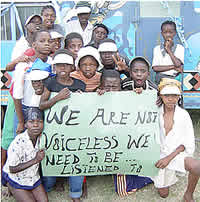|
Back to Index
Perspectives
on children's participation in the Zimbabwean media
Nqaba
Terence Ndlovu, Salvation Army Masiye Camp
October
29, 2004
  The
United Nations Committee on the Rights of the Child has, as one of the
principles of the U.N. Convention, Article 13 which reads in part, "The
child shall have the right to freedom of expression, this right shall
include freedom to seek, receive and impart information and ideas of all
kinds, regardless of frontiers, either orally, in writing or in print,
in the form of art, or through any other media of the child’ choice".
Since ratifying the Convention Zimbabwe has to a limited extent begun
to implement this particular principle that guarantees children’s participation
in the media. The participation of children in the media in Zimbabwe is
largely low key if not downright cosmetic. The
United Nations Committee on the Rights of the Child has, as one of the
principles of the U.N. Convention, Article 13 which reads in part, "The
child shall have the right to freedom of expression, this right shall
include freedom to seek, receive and impart information and ideas of all
kinds, regardless of frontiers, either orally, in writing or in print,
in the form of art, or through any other media of the child’ choice".
Since ratifying the Convention Zimbabwe has to a limited extent begun
to implement this particular principle that guarantees children’s participation
in the media. The participation of children in the media in Zimbabwe is
largely low key if not downright cosmetic.
Whilst programmes
have been initiated where children plan and present on national television,
most of these programmes have children as their target audience. This
in itself is commendable, but if the media is to promote collective action
and policy change, and if children can become agents of change and fully
participate in the development process, then they should be given space
on more important slots like News at Eight, front pages of newspapers
and on talk radio. This will enable them to reach out more effectively
to policymakers and the general public. It would also be beneficial to
communities to add children’s voices to the debate on development issues.
  Elsewhere
on the continent, some developing countries have made significant strides
in ensuring theeffectiveparticipation of children in the media. "In
Albania, child journalists produce a show called "Troc" (meaning
tell it like it is). The show which is broadcast on Albanian National
T.V., by children aged between 13 and 18, has an audience of nearly 75
000 viewers weekly. With Unicef support, Troc is proving to be one the
most innovative and influential forms of youth participation in the world.Children
themselves write and produce the programmes, which are not only popular,
but often produce change. Elsewhere
on the continent, some developing countries have made significant strides
in ensuring theeffectiveparticipation of children in the media. "In
Albania, child journalists produce a show called "Troc" (meaning
tell it like it is). The show which is broadcast on Albanian National
T.V., by children aged between 13 and 18, has an audience of nearly 75
000 viewers weekly. With Unicef support, Troc is proving to be one the
most innovative and influential forms of youth participation in the world.Children
themselves write and produce the programmes, which are not only popular,
but often produce change.
In one instance, a
month after an expose by Troc reporters showed the poor treatment of children
in a dormitory, local authorities met with the director of the dorimitory
and fired him. In another case, after the show highlighted the lack of
textbooks in high schools in one town, educational authorities promptly
provided textbooks in time for students to study for exams" (Unicef).
This is just an example of a "best practice" in participation
of children in the media. If the Albania scenario was to be replicated
in Zimbabwe, the selected children would have to be empowered with the
relevant journalistic and broadcasting skills.
By ratifying the U.N.
Convention in Geneva in 1989, Zimbabwe agreed to "encourage the mass
media to disseminate information and material of social and cultural benefit
to the child". It is interesting to note that the portrayal of children
in the media in Zimbabwe is based more on the news value associated with
children rather than being the product of a proactive agenda for contributing
to the advancement of children. This has often led to children being portrayed
in the media as being "innocent victims" of all sorts of ills
because of the news value of such stories.
Children often become
newsworthy only when something bad has happened to them. The way children
are portrayed in the media has a profound impact on the way people perceive
children and childhood. This also has a psychological effect on the children
themselves. Children’s hopes and aspirations and even expected roles in
life, are to a large extent shaped by the images of children they see
in the media. Therefore, whilst every effort must be made to ensure that
children participate in the media, every effort must also be made to protect
children from the harmful effects of the media. The child’s integrity
must be protected at all costs. It would also be refreshing to have journalists
who are overtly proactive in advocating for children’s rights with the
same passion as environmental issues perhaps. "News value" or
"profitability should not be an impediment to the participation of
children in the media. In this sense therefore, Zimbabweans would need
to undergo a paradigm shift before children can participate fully and
meaningfully in the media.
Visit the Salvation
Army Masiye Camp fact sheet
Please credit www.kubatana.net if you make use of material from this website.
This work is licensed under a Creative Commons License unless stated otherwise.
TOP
|

